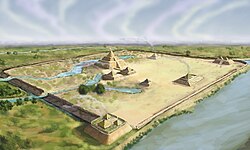Troyville Earthworks

Troyville Earthworks
|
|
| Location |
Catahoula Parish, Louisiana, |
|---|---|
| Region | Catahoula Parish, Louisiana |
| Coordinates | 31°37′36.59″N 91°48′56.12″W / 31.6268306°N 91.8155889°W |
| History | |
| Founded | 100 BCE |
| Abandoned | 1100 CE |
| Cultures | Baytown culture, Troyville culture-Coles Creek culture |
| Site notes | |
| Excavation dates | 1931-1932, |
| Archaeologists | Winslow Walker |
| Architecture | |
| Architectural styles | platform mounds, plaza |
| Responsible body: private | |
Troyville Earthworks (16 CT 7) is a Woodland period Native American archaeological site with components dating from 100 BCE to 700 CE during the Baytown to the Troyville-Coles Creek periods. It once had the tallest mound in Louisiana at 82 feet (25 m) in height. It is located in Catahoula Parish, Louisiana in the town of Jonesville. The site is the type site for the Troyville culture of the lower Ouachita and Tensas River valleys. Before it was destroyed for bridge approach fill in 1931, Troyville was one of the largest mound groups in North America.
The site is at the confluence of the Tensas, Ouachita, and Little Rivers. It had nine platform mounds and a perimeter embankment that were built before 700 CE. A historian, John W. Monette, in 1844 described the complex as occupying close to 400 acres and noted the existence of twelve small mounds and one large one. The embankment was started during the Middle Baytown period, with periodic repair work taking place during the Late Baytown period. The largest mound, Mound 5 ( also known as the “Great Mound” ), was 82 feet (25 m) in height. It was the tallest precolumbian mound in Louisiana and the second tallest in North America. Its base covered an acre of ground and had three levels, the bottom two rectangular and the third on the top a truncated conical mound. Monette described the lower level of Mound 5 as being 300 feet (91 m) by 150 feet (46 m) at its base and rising to the height of 30 feet (9.1 m). He described the conical mound at the top as 30 feet (9.1 m). Measurements for the smaller mounds at the site were about 12 feet (3.7 m) to 20 feet (6.1 m) in height with bases measuring 150 feet (46 m) by 60 feet (18 m). Four of the mounds were surrounded on the southern and western side of the plaza by the embankment, which measured 10 feet (3.0 m) in height, 10 feet (3.0 m) in width and 100 feet (30 m) across.
...
Wikipedia

